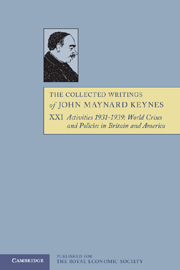Book contents
- Frontmatter
- Contents
- General introduction
- Editorial note
- 1 THE CURRENCY QUESTION
- 2 CHEAP MONEY, WISE SPENDING AND THE MEANS TO PROSPERITY
- 3 THE WORLD ECONOMIC CONFERENCE
- 4 THE NEW DEAL
- 5 THE LULL SURROUNDING THE GENERAL THEORY
- 6 SLUMP AND REARMAMENT
- 7 TOWARDS WAR
- List of Documents Reproduced
- Acknowledgements
- Index
3 - THE WORLD ECONOMIC CONFERENCE
Published online by Cambridge University Press: 05 November 2012
- Frontmatter
- Contents
- General introduction
- Editorial note
- 1 THE CURRENCY QUESTION
- 2 CHEAP MONEY, WISE SPENDING AND THE MEANS TO PROSPERITY
- 3 THE WORLD ECONOMIC CONFERENCE
- 4 THE NEW DEAL
- 5 THE LULL SURROUNDING THE GENERAL THEORY
- 6 SLUMP AND REARMAMENT
- 7 TOWARDS WAR
- List of Documents Reproduced
- Acknowledgements
- Index
Summary
In June and July 1932 the representatives of nineteen countries met at Lausanne to discuss the future of reparations and War debts. The upshot of almost a month's discussion was an end to reparations and a decision to ask the League of Nations to call a World Conference the next year ‘to decide upon the measures to solve the other economic and financial difficulties which are responsible for, and may prolong, the present world crisis’.
Before the Lausanne Conference H. D. Henderson prepared a memorandum entitled ‘A Monetary Proposal for Lausanne’ which suggested that the Bank for International Settlements should issue notes to governments, which would be the equivalent of gold, thus increasing international liquidity and allowing countries to repay debts or engage in expansionary domestic policies. With the note issue proposal came several conditions-the adoption of fixed but adjustable parities, the removal of exchange restrictions and the agreement to repay advances as prices rose towards their 1928 level. The total issue suggested was about £1,000 millions.
During the Lausanne Conference Keynes mentioned the plan to the Prime Minister, reporting that he was ‘strongly in favour of it’ and suggesting that if Lausanne could settle the reparations issue and if the world then proceeded on lines such as Henderson's ‘I should begin to believe that our troubles are at an end’.
Henderson's proposals went to the Committee on Economic Information in July 1932 while it was preparing its Fourth Report. The scheme was incorporated into the Fourth Report which was presented on 20 July.
- Type
- Chapter
- Information
- The Collected Writings of John Maynard Keynes , pp. 203 - 288Publisher: Royal Economic SocietyPrint publication year: 1978

